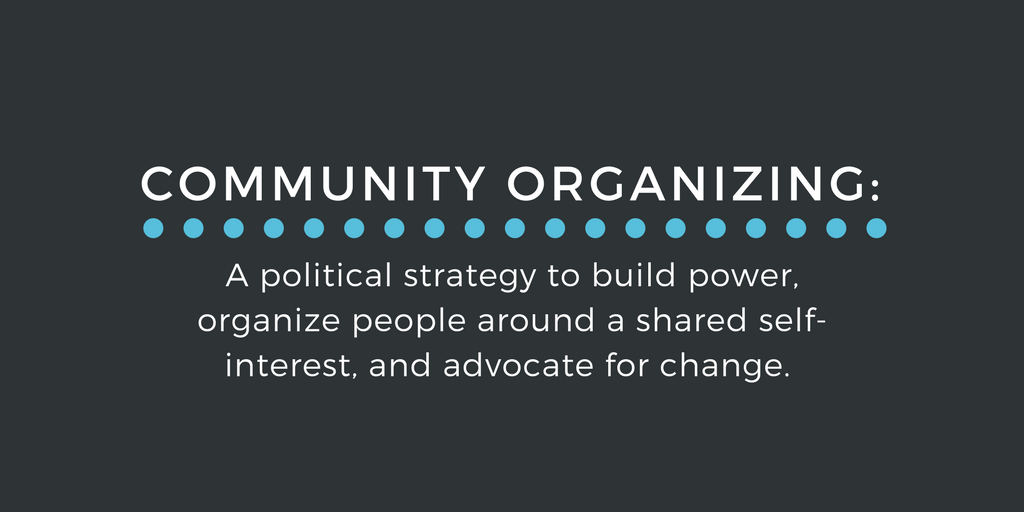What do César Chávez, Dr. Martin Luther King, Jr, Mary Harris “Mother” Jones, Ella Baker, Rosa Parks, and Lois Gibbs all have in common?
They are all well-known community organizers.
Community organizing is not as often in our society’s vernacular since President Obama, the one-time community organizer turned president, left office. At the time of his nomination for the 2008 presidential election, Republican politicians derided his status as a community organizer, with former New York City mayor Rudolph Giuliani notably stating at the Republican National Convention: “What does a community organizer actually do?”
Community organizing is a political strategy to build power, organize people around a shared self-interest, and advocate for change. I worked very briefly in 2009 for a national community organizing group that focused on faith-based community organizing (FBCO) to advance social justice. This was a formative experience for my development. Once I entered higher education and student affairs, I have thought about how higher education professionals can adapt community organizing models to create positive institutional changes.

Community organizing is a complicated and nuanced topic, but this will serve as a primer to generate creative thinking about how we can expand our skill sets as professionals:

Lesson One: Leadership is Not Positional – It is Based on Relationships
I started community organizing after working two years in higher education following my undergraduate experience. Like your classic higher education nerd, I had a poster in my new office outlining what it meant to be a “leader” – some fluffy poster about leadership attributes.
My new community organizing boss came into my office, gave it a derisive glance, and said “You know that’s not actual leadership, right?” in a snide voice. To be honest, his delivery made me completely disagree with him…but eventually I came to admit that he was right.
Consider this: The president or chancellor is the head of an institution and there is an organizational chart that carefully outlines a “chain of command.” But does it hold true that title is the same as power? Absolutely not. The most powerful folks on a campus are often those with the widest net of well-nourished relationships with other professionals on campus.
This can be difficult to remember because the field of higher education adores hierarchy. We are often taught to follow titles. But how often have we met someone with a nice title that is completely ineffective (for whatever the reason) to accomplishing goals?
To imagine how this may work, let’s discuss a scenario. In September, the Trump administration decided to end the Deferred Action for Childhood Arrivals (DACA), leaving the 18% of DACA recipients currently enrolled in college at immediate risk of losing their status before completing their degree. Many universities with DACA recipients immediately responded to the issue, and many even developed initiatives and committees to support DACA students. But what if an institution didn’t?
As an employee, would you go straight to the president? Likely not, unless you are a Provost. So, who then do you talk to in order to get the university moving on an issue that affects DACA students? It is easier said than done, but you would strategize your own connections and analyze who on your campus has the relationships to make things happen.
By approaching them (directly if you have the connection, but more likely you’d approach a connection you have that has a good relationship with your ultimate key leader), you can get the ball rolling on a lot of stuff. In this example, maybe you would want to court a faculty leader who supports minoritized student issues and also has the ear of the president. Or perhaps the administrative assistant of a vice president who can advocate for a meeting to get set up between you and the VP.
Lesson Two: Build Relationships
One must build relationships on a campus across their unit, division, other divisions, and across into academic affairs. Depending on one’s position, this may or may not come naturally. However, if you are interested in addressing change on your campus, you must make the time to do coffee, lunch, or office chats – and go out of your way to continue these past that one coffee you had with someone two summers ago. Again, this is easier said than done. Likewise, this endeavor should not be seen as a video game where you collect coins every time you talk to someone; the goal should be to genuinely get to know one another and build community.
Lesson Three: Discover Self-Interest
As relationships are built, work to understand the self-interest of the professionals on your campus. “Self-Interest” equates to the specific interests of an individual. Your goal is to understand their self-interest and the roots of that interest.
For example, I am passionate about educating first-generation college students. You may ask why, and I will tell you that it is because I am a first-generation student myself. Too often, polite conversation has us stop there. But, authentic conversation and community building means understanding a person’s “why.”
Imagine you’re a rabbit after some delicious-looking carrots in the ground. Could you nibble at the top part sticking out of the ground and then walk off? Well, sure! But that isn’t satisfying. What is satisfying is digging deeper until you reach the end of the root. In this scenario, you’d next ask “How did your experiences as a first-gen student affect your desire to support other first-gen students?”
I guarantee you’d get a clearer idea of my passions and “self-interest.”
Lesson Four: Build Power
We cannot rely on a singular hero to save us every time an issue must be addressed on campus.
Community organizing is about building power, not building a movement. In history, movements end after they have an end result (whether it is a win or a loss). These groups of people disperse and it will take a good deal of cajoling to bring a group together again once the (first) movement is over. They will say “I did my part” or “I did not like the result” or something else. Favors run out, but continuous organizations of people do not.
The goal is to link up individuals with similar self-interests, even if they do not seem too similar. Understanding the “root” of a person’s self-interest better allows you to link up colleagues who may have similar interests who may not appear to have much in common otherwise. This is where “building power” can develop.
Professionals with shared self-interests and who have relationships with one another can be called upon to support new projects or initiatives in a quick and reliable fashion. Of course, this organization of individuals (be it formal or informal) will look different depending on the people, institution, and shared self-interests.
This is just a brief overview of basic community organizing principles that can be applied to higher education. Notably, we have some in the profession who are experienced former or current community organizers. If you would like to expand or share strategies, let us know on Twitter @themoderncampus and @NikiMessmore.








